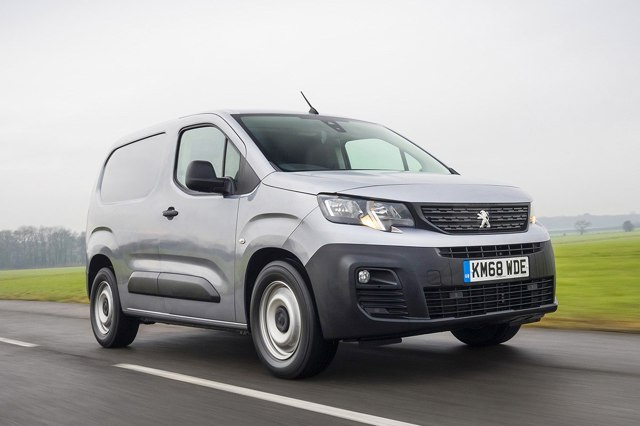Excellent range of petrol and diesel engines.
One-tonne payload capacity.
Affordable fuel costs.
Petrol engines not available until late-2019.
Most of the best tech features cost extra.
June 2018
All-new Peugeot Partner launched
Combining practicality with a dynamic drive, the Partner promises a stress-free mobile office and safety for all professional clients in the LCV segment.
New Partner is fitted with cutting-edge technology which creates a stimulating, instinctive and safe driving experience. This includes i-Cockpit as standard and an overload alert system.
The mass is automatically measured when the ignition is switched on and can also be measured from the load area when the vehicle is stationary. Once 90 per cent of the total load capacity has been reached, a white LED lights up on the control button; if the maximum authorised load is exceeded a yellow LED lights up, supplemented by a visual warning on the dashboard.
A large eight-inch colour touch screen provides connectivity. Located within easy reach and tilted towards the driver, it comes with two USB sockets, one auxiliary socket and Bluetooth. Wireless smartphone charging is also available as an option. The system is supplemented by Mirror Screen that is compatible with Mirror Link, Apple Carplay and Android Auto.
The connected 3D navigation system features voice control, enabling points of interest to be found in a simple and intuitive way. A 3 year subscription is offered free of charge, providing real-time traffic conditions (TomTom Traffic) and live information related to car-parks, fuel stations and the weather forecast on your route.
Standard versions have a capacity ranging from 3.30m3 to 3.80m3 depending on the version, this is sufficient to accommodate two Europallets. The Long version, which is 4,75m long (+35cm), provides even greater load capacity. The effective length of this version is 2.16m and a load capacity ranging from 3.90m3 to 4.40m3.
Six anchoring rings are provided as standard to ensure that your loads are safely secured. As an option, four more mid-height load securing rings, a 12v socket and superior lighting with 6 LEDs providing an output of 237lm may be added.
The standard nearside sliding side door on Standard versions makes for excellent accessibility. An additional offside sliding side door is available as an option on Standard versions and is standard equipment on Long versions.
Petrol engines feature two versions of the 1.2 PureTech engine; a PureTech 130 S&S with EAT8 eight-speed automatic transmission (available in 2019) and a PureTech 110 S&S with manual six-speed gearbox. PureTech engines are fitted with a Gasoline Particulate Filter to reduce particle emissions.
Three diesel engines are available; a BlueHDi 130 S&S with manual 6-speed gearbox or EAT8 eight-speed automatic transmission, a BlueHDi 100 S&S with manual five-speed gearbox and a BlueHDi 75 with manual five-speed gearbox. Diesel engines are all fitted with a FAP particle filter and a selective catalytic reduction system (SCR). This technology reduces emissions as soon as the ignition is switched on.
September 2018
Peugeot Partner named International Van of the Year 2019
The third generation best-seller was crowned by a panel of 25 journalists and independent magazine editors who specialise in Light Commercial Vehicles (LCVs). While improving its space and practicality, New Partner was also recognised for its style, increased comfort, technologies and features worthy of today’s passenger cars.
“The engineers and designers succeeded for the first time in the history of LCVs to create a multi-brand cooperation van, where all brands maintain their core values and brand personality without almost any compromise,” said a spokesperson for the International Van of the Year jury.
October 2018
Peugeot Partner available from £15,825 +VAT
Third generation Partner Van bears all the hallmarks of the first two generations and brings increased loading capacities, improved dynamics, digital i-Cockpit and greater levels of driver assistance.
The all-new Partner Van introduces new-to-segment technology, including a new overload indicator that will inform the driver when the maximum authorised mass is exceeded, and Surround Rear Vision which enhances the driver’s rear-view visibility, feeding back footage from two cameras to display on a five-inch colour screen that replaces the traditional rear-view mirror.
It also features Flankguard – a system informing the driver of the proximity of objects to the side of the manoeuvering vehicle and an Automatic Electronic Parking Brake (included with the Multi-Flex passenger seat and available as an option in vehicles with a single passenger seat).
It comes available as a Panel Van, with two body and wheelbase lengths, four trim levels including two dedicated ‘Ready-To-Go’ versions – Asphalt and Grip – to suit different customer needs and a wide range of engines and gearboxes.
The S trim comes with DAB radio, Bluetooth hands-free, Connect SOS & Assistance, electric windows, automatic headlights, nearside sliding door, full steel bulkhead, Electronic Stability Control and ABS with Hill Start Assist, EBA and EBFD as standard. Prices start at £15,825 for the Standard version and £17,800 for the Long version.
Professional trim level adds air conditioning, rear-parking sensors, 8-inch capacitive colour touchscreen with MirrorLink, six-way adjustable driver’s seat, cruise control with programmable speed limiter and automatic electronic parking brake. Prices start at £17,425 for the Standard length and £19,400 for the Long length.
The Grip level has been designed for drivers that need to transport heavy equipment and up to three people. Benefitting from three front seats, 30mm raised ground clearance, a protective plate under the engine and enhanced traction thanks to Grip Control with Hill Assist Descent, this is ideal for traversing difficult to access environments. This robust model stands apart with its large 690mm wheels fitted with Mud and Snow tyres as well as a payload of up to 1000kg and Overload Indicator technology.
The standard Loading Pack offers LED lighting to the load area, four additional mid-height load-securing rings and a 220V power socket. Prices for Grip start at £17,075 for the Standard version and £18,700 for the Long version.
Asphalt is built for drivers making longer trips or numerous deliveries in urban areas. Benefiting from specific acoustic and thermal enhancements, an 8-inch capacitive colour touchscreen with Connect 3D Navigation with voice recognition and DAB radio. The Surround Rear Vision system, Automatic Electronic Parking Brake and Visibility Pack with automatic headlights and windscreen wipers all help to reduce the stress of daily driving. 16-inch alloy wheels alongside body coloured side rubbing strips, door handles, exterior rear view mirrors and rear bumper. Prices start at £19,970 for the Standard version and £21,820 for the Long version.







_COLON_no_upscale()/cdn.uk.prod.group-mobility-trader.com/images/cas/6bd069ecadecb287142c3f4f21a3526d/534458e457dda57d27c3948f47108c8c.jpg)

 Excellent range of petrol and diesel engines, one-tonne payload capacity, affordable fuel costs.
Excellent range of petrol and diesel engines, one-tonne payload capacity, affordable fuel costs.
 Mid spec vans are expensive, petrol engines not available until late-2019, small steering wheel will not suit everyone.
Mid spec vans are expensive, petrol engines not available until late-2019, small steering wheel will not suit everyone.

_COLON_no_upscale()/cdn.uk.prod.group-mobility-trader.com/images/cas/51fa700300e6b5cd53448beb59b98b04/e378f542412406ce7b632fb926e56956.jpg)
_COLON_no_upscale()/cdn.uk.prod.group-mobility-trader.com/images/cas/756e95ee5d4ade1a4d537021709a3b51/9ea863cc8d9e1c5799b665092bc32d5e.jpg)
_COLON_no_upscale()/cdn.uk.prod.group-mobility-trader.com/images/cas/bd88711e6f80ae7d72903211540b11a0/57c2c16bb557c4b0c8ac401bb51fb863.jpg)